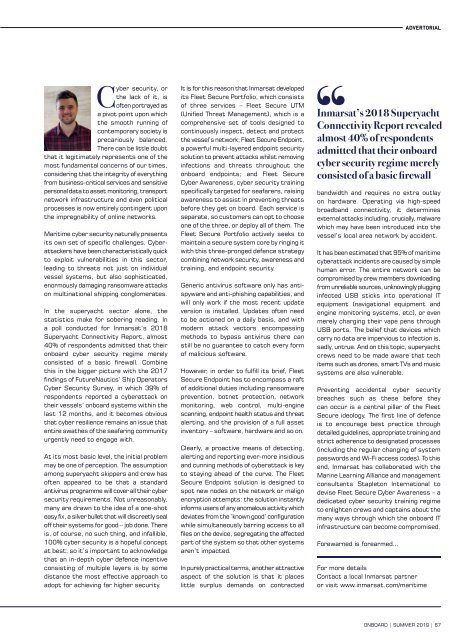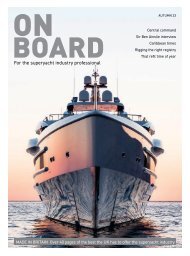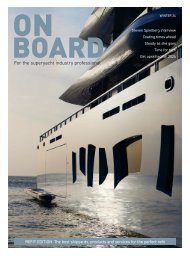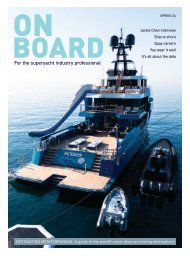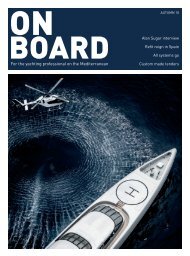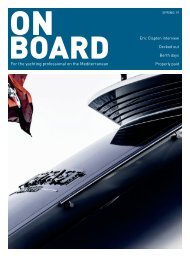ONBOARD Magazine summer 2019
Each issue of ONBOARD Magazine is packed with entertaining and informative features – from technical and educational to lighthearted and lifestyle. All specifically aimed at the yachting professionals with buying power. Our renowned team of journalists and in-house editors deliver regular news items, interviews, reviews and features on essential products and services for every superyacht professional, whether at work or when having fun. The summer 2019 edition is out now and includes features on Electric Tenders, VSAT, Registration, Marinas in the eastern Mediterranean, Interior linens and fabrics, RIBs and what to do when you have expensive artwork on board. Plus, don’t forget to review our 2019 Tenders & Toys supplement. This annual publications includes all you need to know about the latest and great toys, ATVs, Jet Boards, a look at support vessels, gyms and exercise areas on board yachts and our industry leading A-Z tender listing with over 130 vessels.
Each issue of ONBOARD Magazine is packed with entertaining and informative features – from technical and educational to lighthearted and lifestyle. All specifically aimed at the yachting professionals with buying power. Our renowned team of journalists and in-house editors deliver regular news items, interviews, reviews and features on essential products and services for every superyacht professional, whether at work or when having fun. The summer 2019 edition is out now and includes features on Electric Tenders, VSAT, Registration, Marinas in the eastern Mediterranean, Interior linens and fabrics, RIBs and what to do when you have expensive artwork on board. Plus, don’t forget to review our 2019 Tenders & Toys supplement. This annual publications includes all you need to know about the latest and great toys, ATVs, Jet Boards, a look at support vessels, gyms and exercise areas on board yachts and our industry leading A-Z tender listing with over 130 vessels.
Create successful ePaper yourself
Turn your PDF publications into a flip-book with our unique Google optimized e-Paper software.
ADVERTORIAL<br />
Cyber security, or<br />
the lack of it, is<br />
often portrayed as<br />
a pivot point upon which<br />
the smooth running of<br />
contemporary society is<br />
precariously balanced.<br />
There can be little doubt<br />
that it legitimately represents one of the<br />
most fundamental concerns of our times,<br />
considering that the integrity of everything<br />
from business-critical services and sensitive<br />
personal data to asset monitoring, transport<br />
network infrastructure and even political<br />
processes is now entirely contingent upon<br />
the impregnability of online networks.<br />
Maritime cyber security naturally presents<br />
its own set of specific challenges. Cyberattackers<br />
have been characteristically quick<br />
to exploit vulnerabilities in this sector,<br />
leading to threats not just on individual<br />
vessel systems, but also sophisticated,<br />
enormously damaging ransomware attacks<br />
on multinational shipping conglomerates.<br />
In the superyacht sector alone, the<br />
statistics make for sobering reading. In<br />
a poll conducted for Inmarsat’s 2018<br />
Superyacht Connectivity Report, almost<br />
40% of respondents admitted that their<br />
onboard cyber security regime merely<br />
consisted of a basic firewall. Combine<br />
this in the bigger picture with the 2017<br />
findings of FutureNautics’ Ship Operators<br />
Cyber Security Survey, in which 39% of<br />
respondents reported a cyberattack on<br />
their vessels’ onboard systems within the<br />
last 12 months, and it becomes obvious<br />
that cyber resilience remains an issue that<br />
entire swathes of the seafaring community<br />
urgently need to engage with.<br />
At its most basic level, the initial problem<br />
may be one of perception. The assumption<br />
among superyacht skippers and crew has<br />
often appeared to be that a standard<br />
antivirus programme will cover all their cyber<br />
security requirements. Not unreasonably,<br />
many are drawn to the idea of a one-shot<br />
easy fix, a silver bullet that will discreetly seal<br />
off their systems for good – job done. There<br />
is, of course, no such thing, and infallible,<br />
100% cyber security is a hopeful concept<br />
at best; so it’s important to acknowledge<br />
that an in-depth cyber defence incentive<br />
consisting of multiple layers is by some<br />
distance the most effective approach to<br />
adopt for achieving far higher security.<br />
It is for this reason that Inmarsat developed<br />
its Fleet Secure Portfolio, which consists<br />
of three services – Fleet Secure UTM<br />
(Unified Threat Management), which is a<br />
comprehensive set of tools designed to<br />
continuously inspect, detect and protect<br />
the vessel’s network; Fleet Secure Endpoint,<br />
a powerful multi-layered endpoint security<br />
solution to prevent attacks whilst removing<br />
infections and threats throughout the<br />
onboard endpoints; and Fleet Secure<br />
Cyber Awareness, cyber security training<br />
specifically targeted for seafarers, raising<br />
awareness to assist in preventing threats<br />
before they get on board. Each service is<br />
separate, so customers can opt to choose<br />
one of the three, or deploy all of them. The<br />
Fleet Secure Portfolio actively seeks to<br />
maintain a secure system core by ringing it<br />
with this three-pronged defence strategy<br />
combining network security, awareness and<br />
training, and endpoint security.<br />
Generic antivirus software only has antispyware<br />
and anti-phishing capabilities, and<br />
will only work if the most recent update<br />
version is installed. Updates often need<br />
to be actioned on a daily basis, and with<br />
modern attack vectors encompassing<br />
methods to bypass antivirus there can<br />
still be no guarantee to catch every form<br />
of malicious software.<br />
However, in order to fulfill its brief, Fleet<br />
Secure Endpoint has to encompass a raft<br />
of additional duties including ransomware<br />
prevention, botnet protection, network<br />
monitoring, web control, multi-engine<br />
scanning, endpoint health status and threat<br />
alerting, and the provision of a full asset<br />
inventory – software, hardware and so on.<br />
Clearly, a proactive means of detecting,<br />
alerting and reporting ever-more insidious<br />
and cunning methods of cyberattack is key<br />
to staying ahead of the curve. The Fleet<br />
Secure Endpoint solution is designed to<br />
spot new nodes on the network or malign<br />
encryption attempts: the solution instantly<br />
informs users of any anomalous activity which<br />
deviates from the ‘known good’ configuration<br />
while simultaneously barring access to all<br />
files on the device, segregating the affected<br />
part of the system so that other systems<br />
aren’t impacted.<br />
In purely practical terms, another attractive<br />
aspect of the solution is that it places<br />
little surplus demands on contracted<br />
Inmarsat’s 2018 Superyacht<br />
Connectivity Report revealed<br />
almost 40% of respondents<br />
admitted that their onboard<br />
cyber security regime merely<br />
consisted of a basic firewall<br />
bandwidth and requires no extra outlay<br />
on hardware. Operating via high-speed<br />
broadband connectivity, it determines<br />
external attacks including, crucially, malware<br />
which may have been introduced into the<br />
vessel’s local area network by accident.<br />
It has been estimated that 95% of maritime<br />
cyberattack incidents are caused by simple<br />
human error. The entire network can be<br />
compromised by crew members downloading<br />
from unreliable sources, unknowingly plugging<br />
infected USB sticks into operational IT<br />
equipment (navigational equipment and<br />
engine monitoring systems, etc), or even<br />
merely charging their vape pens through<br />
USB ports. The belief that devices which<br />
carry no data are impervious to infection is,<br />
sadly, untrue. And on this topic, superyacht<br />
crews need to be made aware that tech<br />
items such as drones, smart TVs and music<br />
systems are also vulnerable.<br />
Preventing accidental cyber security<br />
breaches such as these before they<br />
can occur is a central pillar of the Fleet<br />
Secure ideology. The first line of defence<br />
is to encourage best practice through<br />
detailed guidelines, appropriate training and<br />
strict adherence to designated processes<br />
(including the regular changing of system<br />
passwords and Wi-Fi access codes). To this<br />
end, Inmarsat has collaborated with the<br />
Marine Learning Alliance and management<br />
consultants Stapleton International to<br />
devise Fleet Secure Cyber Awareness – a<br />
dedicated cyber security training regime<br />
to enlighten crews and captains about the<br />
many ways through which the onboard IT<br />
infrastructure can become compromised.<br />
Forewarned is forearmed...<br />
For more details<br />
Contact a local Inmarsat partner<br />
or visit www.inmarsat.com/maritime<br />
<strong>ONBOARD</strong> | SUMMER <strong>2019</strong> | 67


